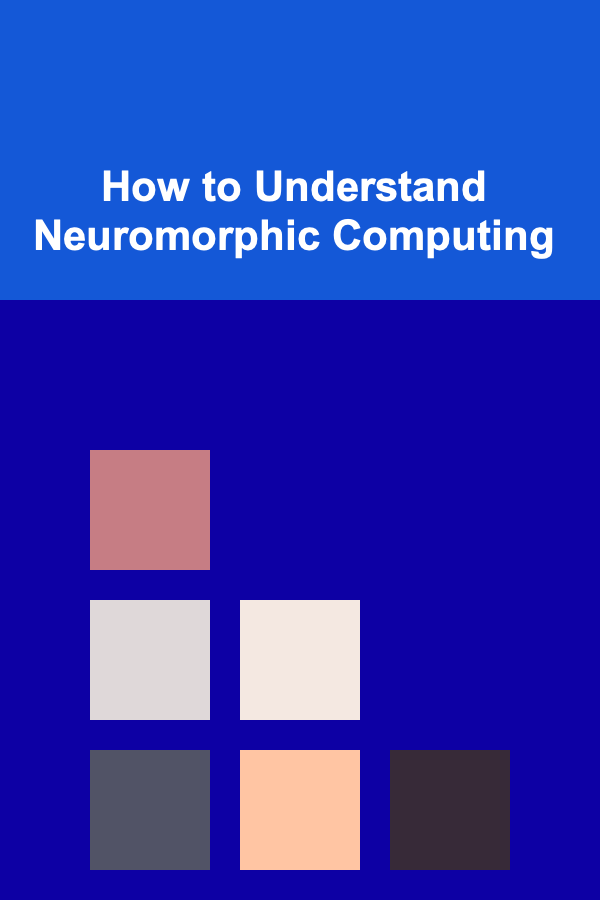
How to Understand Neuromorphic Computing
ebook include PDF & Audio bundle (Micro Guide)
$12.99$6.99
Limited Time Offer! Order within the next:

Neuromorphic computing represents a paradigm shift in computing systems, emulating the structure and function of the human brain to build more efficient, intelligent, and energy-conscious machines. In an era where artificial intelligence (AI) and machine learning (ML) are making significant advancements, neuromorphic computing is poised to revolutionize these fields by mimicking the very architecture that allows the brain to perform complex tasks with remarkable efficiency.
This article delves into the principles, components, and potential applications of neuromorphic computing. We will explore its evolution, the key technologies enabling it, and the challenges it faces in becoming a mainstream solution. By the end of this article, you should have a comprehensive understanding of neuromorphic computing and its promising future.
What is Neuromorphic Computing?
Neuromorphic computing is a branch of computer science and engineering that seeks to design computing systems inspired by the biological processes of the brain. It involves creating hardware and software systems that replicate neural structures, such as neurons, synapses, and their complex interconnections, in a manner that can be used to solve real-world problems in a much more efficient and adaptive way than traditional computing models.
The Biological Inspiration
The term "neuromorphic" comes from the Greek word neuron , meaning nerve, and morphos, meaning shape or form. The goal of neuromorphic computing is to build systems that mirror the way the human brain processes information, which involves numerous neurons connected by synapses. Neurons are specialized cells in the brain that receive, process, and transmit information via electrical impulses, while synapses are the junctions through which neurons communicate with each other.
Unlike traditional von Neumann computing, where data is processed sequentially in a central processor, neuromorphic systems aim to model the brain's parallel processing approach, where thousands of neurons work in unison to process information in real-time.
The Evolution of Neuromorphic Computing
Neuromorphic computing is a relatively new field, but its roots can be traced back to the early days of artificial intelligence research. In the 1950s and 1960s, AI researchers began investigating how to simulate human cognition and perception using computers. The concept of artificial neural networks (ANNs), which mimics the way biological neurons work, emerged during this time.
In the decades that followed, AI and machine learning research focused primarily on algorithms that simulate the learning process in biological systems. However, these methods, such as backpropagation in neural networks, rely heavily on large-scale data processing and centralized computing power, which leads to energy inefficiency and slower processing times.
The limitations of traditional computing systems led to the rise of neuromorphic computing in the 1980s, with researchers like Carver Mead at Caltech laying the foundation for the field. Mead introduced the concept of neuromorphic engineering, which aims to build hardware that mimics the brain's structure and functioning. His work led to the development of silicon neurons and synapses, which could perform tasks more efficiently than traditional computer chips.
In the 2000s, neuromorphic computing gained more attention as researchers focused on reducing the energy consumption and complexity of AI systems. The development of specialized neuromorphic hardware, such as the IBM TrueNorth chip, and the emergence of large-scale neuromorphic systems marked a significant turning point in the field.
Key Technologies Behind Neuromorphic Computing
Neuromorphic computing is powered by several key technologies that enable the emulation of the brain's neural processes. These include the following:
1. Spiking Neural Networks (SNNs)
Traditional neural networks, like the ones used in deep learning, rely on continuous signals to propagate information through the system. In contrast, Spiking Neural Networks (SNNs) use discrete electrical pulses, or "spikes," to communicate between neurons. These spikes are generated only when a neuron reaches a certain threshold, mimicking the way biological neurons fire in the brain.
SNNs are much more energy-efficient because they process information only when necessary, as opposed to continuously. This makes them well-suited for neuromorphic hardware, which aims to replicate the brain's energy-efficient computations.
2. Neuromorphic Hardware
Neuromorphic hardware refers to specialized processors and circuits designed to mimic the behavior of biological neural networks. Unlike traditional processors, which rely on sequential operations and central control units, neuromorphic hardware uses parallel processing, where many simple units operate simultaneously. The hardware is designed to handle the sparse and asynchronous nature of spiking neural networks.
Examples of neuromorphic hardware include:
- IBM TrueNorth: A large-scale neuromorphic chip that features 1 million neurons and 256 million synapses, designed to process information in parallel, using a fraction of the power required by traditional processors.
- Intel Loihi: Another neuromorphic chip designed by Intel, which uses event-based processing to simulate neural computation. Loihi has been used for a range of applications, including robotics, AI, and cognitive computing.
3. Memristors and Synaptic Plasticity
Memristors are a type of electronic component that can store information in the form of resistance, mimicking the way synapses in the brain change their strength over time based on the signals they receive. This property is known as synaptic plasticity and is a crucial element of learning and memory in biological systems.
Memristors allow neuromorphic systems to adjust their behavior based on experience, much like the human brain does. By using memristors, neuromorphic systems can simulate the adaptive learning process, enabling them to become more efficient and effective over time.
4. Event-Based Processing
Traditional computers process information in a sequential manner, executing operations in response to every bit of data they encounter. In contrast, neuromorphic systems use event-based processing, where information is processed only when significant changes or events occur. This approach is more aligned with how biological systems work, where neurons fire only when they detect meaningful input.
Event-based processing drastically reduces the computational load and energy consumption, making neuromorphic systems well-suited for tasks that require real-time processing and adaptive behavior.
Applications of Neuromorphic Computing
The potential applications of neuromorphic computing are vast and far-reaching. Here are some key areas where neuromorphic systems are expected to make a significant impact:
1. Artificial Intelligence (AI) and Machine Learning
Neuromorphic computing holds the promise of accelerating AI and machine learning by offering a more efficient and adaptive framework for processing data. Traditional AI models, such as deep neural networks, rely on massive amounts of data and computational power, which can be slow and energy-intensive. Neuromorphic systems, by contrast, process information in a way that is more similar to how the brain works, enabling faster and more energy-efficient learning.
Additionally, neuromorphic computing could enable more advanced forms of AI, such as systems that can learn in real-time, adapt to new situations, and operate autonomously without requiring vast amounts of training data.
2. Robotics
Neuromorphic computing has significant implications for robotics, particularly in the areas of perception, decision-making, and control. Robots equipped with neuromorphic systems could process sensory inputs, such as visual and auditory signals, in real-time, enabling them to respond more quickly and efficiently to changes in their environment.
Moreover, neuromorphic systems can help robots learn from experience, making them more autonomous and capable of complex tasks such as navigation, manipulation, and human-robot interaction.
3. Edge Computing and Internet of Things (IoT)
Neuromorphic systems are well-suited for edge computing and IoT applications, where energy efficiency and real-time processing are critical. By using neuromorphic chips to process data at the edge of the network, IoT devices can operate more efficiently, with reduced latency and power consumption.
For example, neuromorphic systems can be used in autonomous vehicles, smart sensors, and wearable devices, enabling them to process information locally and make real-time decisions without relying on cloud-based processing.
4. Neuroscience and Cognitive Computing
Neuromorphic computing can be used as a tool to better understand the brain and the processes that underlie cognition and behavior. By creating computational models of the brain's neural networks, researchers can simulate and study how different areas of the brain work together to process information.
Additionally, neuromorphic systems could be used to build cognitive computing systems that mimic human-like thinking and reasoning, paving the way for more sophisticated AI applications that can interact with humans in a more natural and intuitive way.
Challenges and Limitations
Despite the tremendous potential of neuromorphic computing, there are several challenges and limitations that must be addressed before it can become a mainstream technology.
1. Scalability
While neuromorphic hardware has shown promising results in small-scale demonstrations, scaling these systems to handle large, complex tasks is a significant challenge. The current neuromorphic chips, such as IBM TrueNorth and Intel Loihi, are limited in the number of neurons and synapses they can simulate, making them unsuitable for certain large-scale applications.
2. Programming Complexity
Programming neuromorphic systems is more complex than traditional computing systems due to their unique architecture. Writing software that can take full advantage of neuromorphic hardware requires specialized knowledge of neural networks, spiking neurons, and event-based processing. This makes it difficult for developers to leverage the full potential of neuromorphic systems without a deep understanding of the underlying hardware.
3. Integration with Existing Systems
Integrating neuromorphic computing into existing infrastructure and systems can be challenging. Traditional computing systems are built around sequential processing, while neuromorphic systems operate in parallel and asynchronously. This makes it difficult to interface neuromorphic hardware with existing systems, which may require new software frameworks and programming models.
4. Energy Efficiency vs. Performance Trade-offs
While neuromorphic computing promises energy efficiency, there is often a trade-off between energy savings and processing power. For certain tasks, traditional computing systems may still outperform neuromorphic systems in terms of raw computational power. Finding the right balance between energy efficiency and performance will be key to the widespread adoption of neuromorphic systems.
Conclusion
Neuromorphic computing represents a transformative approach to building intelligent systems, with the potential to revolutionize AI, robotics, and numerous other fields. By mimicking the architecture and function of the human brain, neuromorphic systems can process information in a more energy-efficient, adaptive, and real-time manner than traditional computing models.
While there are still challenges to overcome, such as scalability and programming complexity, the progress made in neuromorphic hardware and software suggests that it could become a cornerstone of future computing technologies. As research and development in this field continue, we can expect to see even more groundbreaking applications that leverage the power of neuromorphic computing to solve some of the most complex problems facing society today.
Reading More From Our Other Websites
- [Screen Printing Tip 101] Step-by-Step: Creating Vibrant Designs Using Vinyl in Screen Printing
- [Skydiving Tip 101] A Day in the Life of a Skydiving Instructor: Behind the Scenes of the Drop Zone
- [Biking 101] How to Maintain Your Spin Bike for a Smooth Ride
- [Home Holiday Decoration 101] How to Add Holiday Vibes to Your Patio or Outdoor Space
- [Personal Care Tips 101] How to Use Deodorant to Manage Sweating Without Antiperspirants
- [Mindful Eating Tip 101] How to Leverage Sensory Journaling to Deepen Your Mindful Eating Practice
- [Rock Climbing Tip 101] Hidden Gems: Underrated Climbing Destinations for Your Next Adventure
- [Personal Financial Planning 101] How to Choose the Best Investment Apps for Your Financial Goals
- [Home Soundproofing 101] How to Soundproof Air Vents and Reduce Noise Transmission
- [Home Soundproofing 101] How to Soundproof Your Home Against Outside Noises

How to Achieve a Scandinavian Look Without Spending Too Much
Read More
How to Create a Festive Home Office with Holiday Decor
Read More
How to Make Your Home More Sustainable During a Renovation
Read More
How To Plan an Accessible Hiking Trip
Read More
How to Find Free Software and Online Tools
Read More
Understanding Blockchain for Enterprise Solutions
Read MoreOther Products

How to Achieve a Scandinavian Look Without Spending Too Much
Read More
How to Create a Festive Home Office with Holiday Decor
Read More
How to Make Your Home More Sustainable During a Renovation
Read More
How To Plan an Accessible Hiking Trip
Read More
How to Find Free Software and Online Tools
Read More